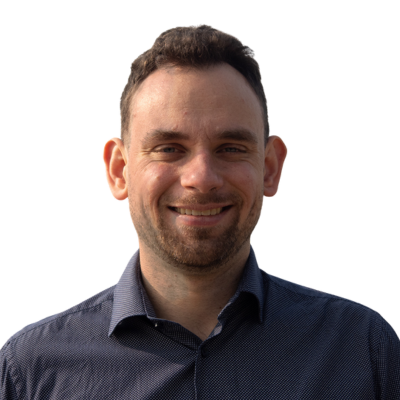3 questions for...

Prof. Dr. Andriy Goychuk
Groupleader
Prof. Dr. Andriy Goychuk researches the self-organization of living matter across various scales – from inflammatory processes and cell dynamics at the tissue level to organization in the cell nucleus and the dynamics of proteins. A focus of his work is the development of numerical methods and theoretical models based on biophysics, statistical mechanics, fluid mechanics, and nonlinear dynamics. After completing his doctorate in physics at Ludwig Maximilian University in Munich in 2021 on cell movements and protein patterns, he conducted postdoctoral research at the Massachusetts Institute of Technology. His work on chromatin organization and biomolecular condensates was funded by the European Molecular Biology Organization. Since 2025, he has led a research group at CAIMed and the Helmholtz Centre for Infection Research.
1.
You work at the intersection of physics, biology, and medicine. What opportunities does this interdisciplinary perspective open up for medical research?
Mathematical and biophysical modeling can help us understand the principles guiding the organization of cells and tissues, and how this organization controls function. Conversely, these same principles provide an opportunity to uncover how and why function is perturbed during diseases. For example, I recently learned during a visit that very different diseases (e.g., viral infections such as Zika and certain genetic defects) can have similar phenomenologies (in that particular example, a change in the architecture of the nuclear pore complex) and clinical outcomes (in that case, developmental delays). I think that shared principles of organization, or shared failure points, can explain why different diseases can have similar features. Beyond explaining the "how" and “why”, modeling also allows testing the feasibility of a potential intervention. The broader vision of my group is to integrate the physical principles of biological organization to understand how cell and tissue homeostasis are perturbed by the expression of viral proteins during infection, cytokine signaling during inflammation, and restored upon recovery.
2.
What fascinates you about describing biological systems with physical principles – and what new perspectives does this create for research within CAIMed?
Biology is incredibly messy and complex. Wherever one looks, one can find inspiration by just wondering: “how"? I still remember the wonder and elation when I saw for the first time how cells self-organized into a network in a model experiment of blood vessel formation in vitro. To me, Physics is all about answering the question of “how”. Of course, the resulting models themselves can be challenging, interesting, and rewarding in their own right. But ultimately, the point is that Physics is tailored to distill minimal principles that convey some truth about a potentially very complex system. Oversimplification is an important feature of this process, because it allows us to develop an intuitive understanding that could lead to a change in perspective. In the same vein, model failure is not a bug but instead teaches us what we have neglected to account for, thereby providing a systematic way of increasing model complexity. Having narrowed down the physical principles, I think that machine learning provides an opportunity to scale up and screen large and interconnected datasets. I am really excited to discuss with the other members of CAIMed where this reductionist approach could be helpful or could benefit from other perspectives.
3.
What opportunities does CAIMed offer for the transfer of AI into clinical practice?
One particular example that I have in mind is strongly related to a project and a question that I had for some time. Some viral proteins localize to specific regions in the cell such as the nucleolus or transcriptional condensates. In other pathologies, mutations or misregulation lead to aberrant localization of proteins. I think that it would be fantastic to better understand the principles and molecular features that underlie protein localization. This understanding could help guide, for example, drug interventions. This is a problem that is strongly related to thermodynamics and statistical mechanics (e.g., chemical potentials and molecular interactions), chemistry (e.g., protonation and deprotonation depending on pH), protein folding (where AI is state of the art), and is incredibly diverse and complex (there are thousands of different protein types that have been found in the nucleolus alone). I envision that my research group in CAIMed will tackle this challenge by combining detailed simulations (coarse-grained molecular dynamics) with machine learning to extract molecular features and biophysical modeling based on first principles.

